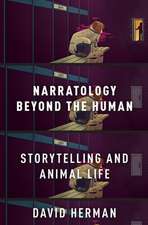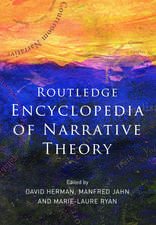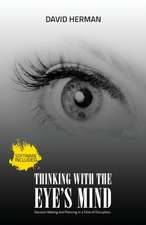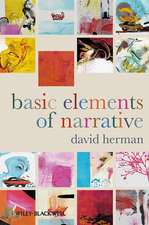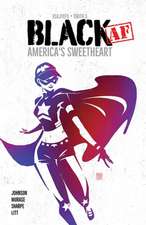Animal Comics: Multispecies Storyworlds in Graphic Narratives
David Hermanen Limba Engleză Paperback – 26 iun 2019
| Toate formatele și edițiile | Preț | Express |
|---|---|---|
| Paperback (1) | 231.89 lei 43-57 zile | |
| Bloomsbury Publishing – 26 iun 2019 | 231.89 lei 43-57 zile | |
| Hardback (1) | 716.24 lei 43-57 zile | |
| Bloomsbury Publishing – 13 dec 2017 | 716.24 lei 43-57 zile |
Preț: 231.89 lei
Preț vechi: 297.64 lei
-22% Nou
Puncte Express: 348
Preț estimativ în valută:
44.38€ • 46.07$ • 37.00£
44.38€ • 46.07$ • 37.00£
Carte tipărită la comandă
Livrare economică 24 martie-07 aprilie
Preluare comenzi: 021 569.72.76
Specificații
ISBN-13: 9781350116955
ISBN-10: 1350116955
Pagini: 280
Ilustrații: 24 bw illus
Dimensiuni: 156 x 234 x 20 mm
Greutate: 0.4 kg
Editura: Bloomsbury Publishing
Colecția Bloomsbury Academic
Locul publicării:London, United Kingdom
ISBN-10: 1350116955
Pagini: 280
Ilustrații: 24 bw illus
Dimensiuni: 156 x 234 x 20 mm
Greutate: 0.4 kg
Editura: Bloomsbury Publishing
Colecția Bloomsbury Academic
Locul publicării:London, United Kingdom
Caracteristici
Crosses multiple fields of study including: comics studies, history, philosophy, sociology, anthropology, and new hybrid areas of study such as anthrozoology
Notă biografică
David Herman has taught at several institutions in the US and, most recently, at Durham University, UK. Growing out of his recent studies on animal narratives across media, his monograph Narratology beyond the Human will be published in 2018.
Cuprins
List of FiguresAcknowledgmentsNotes on ContributorsIntroduction: More-than-Human Worlds in Graphic Storytelling David Herman Part I. Animal Agency in the History and Theory of Comics 1. Lions and Tigers and Fears: A Natural History of the Sequential Animal Daniel F. Yezbick, St Louis Community College, USA 2. The Animalized Character and Style Glenn Willmott, Queen's University, Canada Part II. Species of Difference: Functions of Animal Alterity in Graphic Narratives 3. The Politics and Poetics of Alterity in Adam Hines's Duncan the Wonder Dog Alex Link, Alberta College of Art & Design, Canada 4. The Saga of the Animal as Visual Metaphor for Mixed-Race Identity in ComicsMichael A. Chaney, Dartmouth College, USA 5. Curly Tails and Flying Dogs: Structures of Affect in Nick Abadzi's Laika Carrie Rohman, Lafayette College, USA6. Invasive Species: Manga's Insect-Human WorldsMary A. Knighton, Aoyama Gakuin University, Japan Part III. Critical Frameworks for Multispecies Comics 7. Resituating the Animal Comic: Environmentalist Aesthetics in Matt Dembicki's Xoc: The Journey of a Great White Laura Pearson, University of Leeds, UK 8. Interspecies Relationships in Graphic Micronarratives: From Olivier Deprez to Avril-Deprez Jan Baetens, University of Leuven, Belgium 9. Animal Minds in Nonfiction Comics David Herman Part IV. Graphic Animality in the Classroom and Beyond 10. Can We Be Part of the Pride? Reading Animals through Comics in the Undergraduate Classroom Andrew Smyth and Charles E. Baraw, Southern Connecticut State University, USA 11. This is HomeBridget Brewer and Thalia Field, Brown University, USA Index
Recenzii
With its international and interdisciplinary sweep, this ground-breaking volume examines the ways that comics activate animals as icons and symbols in ways that no other art form possibly can.
If animals cannot speak, they have found in the authors of this fascinating volume the best advocates and interpreters. Animal comics are not a genre but a continent, of which the cartography is delivered here for the first time, in a truly cross-disciplinary perspective.
The essays offer a variety of critical frameworks for examining these comics; e.g., one essay provides a historical overview, with plenty of illustrative examples. Other contributors use a variety of theoretical lenses as they analyze these comics and even discuss animals in nonfiction comics. The final section (of four) should prove extremely helpful for teachers and future teachers: it offers strategies for using animal comics in various classroom settings, from a general education course to a young adult literature class. The variety of topics and texts represented here makes this collection useful across disciplines and interests . The collection is a worthy complement to other books about graphic novels. Summing Up: Recommended.
If animals cannot speak, they have found in the authors of this fascinating volume the best advocates and interpreters. Animal comics are not a genre but a continent, of which the cartography is delivered here for the first time, in a truly cross-disciplinary perspective.
The essays offer a variety of critical frameworks for examining these comics; e.g., one essay provides a historical overview, with plenty of illustrative examples. Other contributors use a variety of theoretical lenses as they analyze these comics and even discuss animals in nonfiction comics. The final section (of four) should prove extremely helpful for teachers and future teachers: it offers strategies for using animal comics in various classroom settings, from a general education course to a young adult literature class. The variety of topics and texts represented here makes this collection useful across disciplines and interests . The collection is a worthy complement to other books about graphic novels. Summing Up: Recommended.

